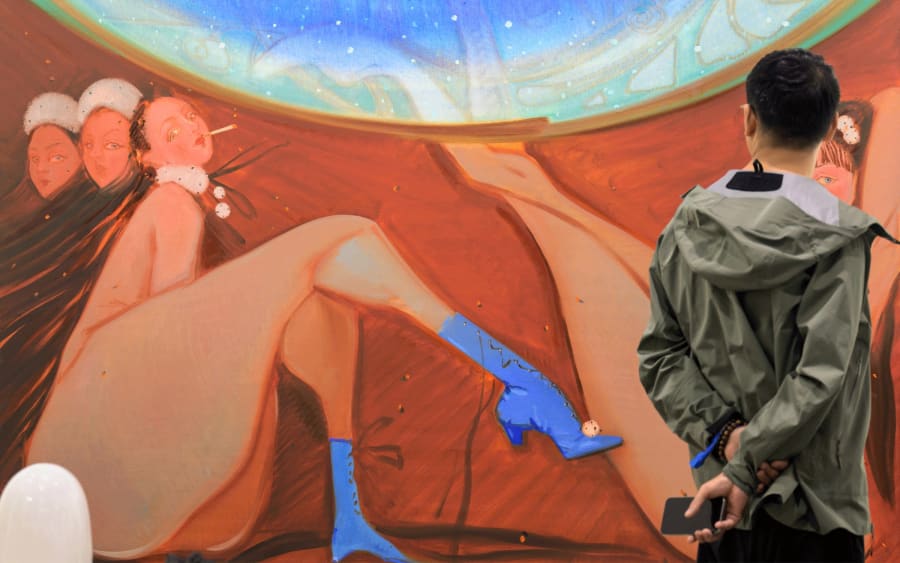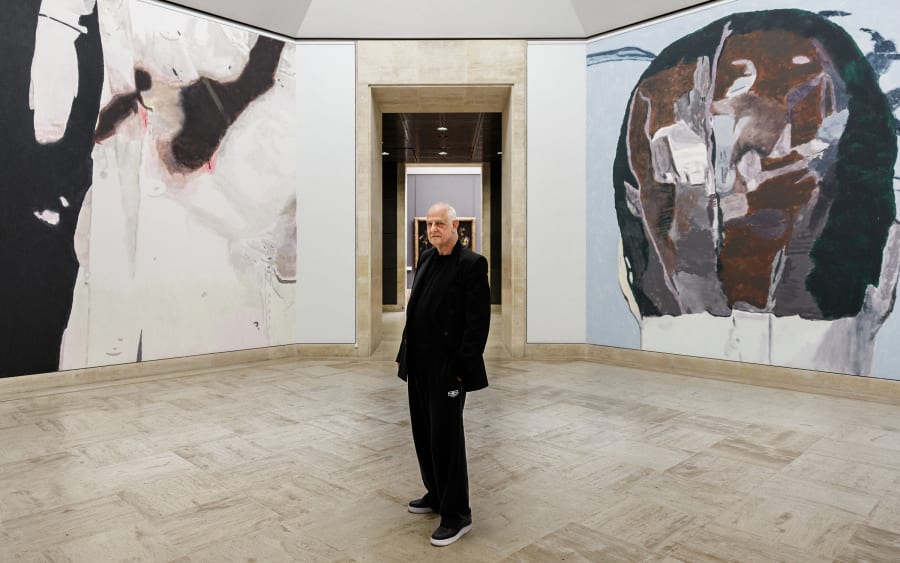畫家Vivian Greven在其位於杜塞爾多夫的工作室裏說:「我感覺我的身體從來都不一樣。它總是處於變化;早上我的身體可能有些僵硬,但當我起床擁抱我的兒子時,我的身體就突然變得舒展起來,與另一個生命融為一體。」Greven的畫作將古典形式與數碼美學結合,探討親密與斷離、神話與蛻變。她的大型作品以平滑、絢麗的色彩表現出支離破碎的人物形象,畫面中的斷裂看起來像是技術故障。 這些圖像具有永恆的特質,但都是關於過渡中的身體,通常捕捉的是碰觸或連接前的瞬間。
在這位德國藝術家於紐約貝浩登(Perrotin)舉辦的首次個展「When the Sun Hits the Moon」中,有幾幅畫作是初次亮相,主題為安東尼奧.卡諾瓦(Antonio Canova)的新古典主義雕塑中描繪的愛神厄洛斯與普姬幾乎接吻的場景。愛神不允許他的世間愛人看到他在光明中的樣子;當普姬拿著蠟燭對著愛神面龐的那一刻,這對戀人就永久地斷開了聯繫。Greven說:「我喜歡這個意象,因為我捕捉到的那一刻,他們還在互相對視,但未真正看見對方的面貌。他們仍處於黑暗之中,以內心注視和以內在擁抱。」
然而,Greven畫筆下人物光潔的身體卻讓人感覺無法碰觸。她認為這些人物是「化身」,他們的完美源自古老的審美理想及螢幕形象。然而,Greven的作品並不是數碼作品,她也並非以數碼工具來製作這些作品。她說:「我非常喜歡通過繪畫讓它們重獲實體感的想法,當畫筆真正劃過畫布才可以真正感受並明白:哦,這是真正成形而非僅是一個螢幕上的形象。」最終,Greven以繪畫的方式將身體還給了觀眾。她的油畫作品揭示了皮膚下不同的深度,而這層皮膚是通過日積月累、精雕細琢的筆觸描繪而成的。從肉體到石頭,從圖元到繪畫,我們最終回到了初始之地:一個身體和另一個身體的相遇。
The specter of larger galleries poaching artists from their emerging peers has been a perennial problem in the art market. In November 2023, Hauser & Wirth came up with one solution: to partner with younger or smaller galleries in representing emerging artists. Such collaborations allow artists to keep operating at a scale they are comfortable at, as well as keeping emerging galleries in business, while providing street cred and new sources of income for the megas.
Linda Pyke, a director at THK Gallery in Cape Town, notes how the relationship between galleries and artists at the outset of their career ‘is often very intense.’ She adds: ‘When you allow that conversation to develop and mature over decades, it will reflect in the art.’ The South African gallery’s program spotlights young artists from Africa and the Global South – as Pyke says, ‘artists who are very much engaged with cultural narratives and identities, with a view to redefining and challenging conventions.’
Pyke came to the gallery world via auction houses, first cutting her teeth at Christie’s in London before joining Phillips. She returned to her native South Africa in 2017 and joined THK Gallery in January 2020, around 18 months after the firm opened, and two months before the pandemic. Pyke says the gallery was quick to adapt to doing business online, holding its first Zoom panel a week after lockdowns began.
Business savvy and a flair for technology are among the defining characteristics needed to thrive in the gallery world today, according to Pyke. ‘This is underpinned, as always, by strong relationships, with both collectors and artists,’ she says.
As Pyke points out, the pivot to more advanced technologies in Africa was rapid. ‘Where we didn’t have working phone landlines, we leap frogged into the mobile age,’ she says. ‘The postal system is also unreliable, so people are already functioning digitally a lot more than in other places. It was necessity at first but now it’s become an advantage.’
While social media and online platforms are key for reaching collectors, most dealers concur that technology remains a communications tool rather than representing a different business model. ‘Ultimately nothing replaces the dinner where you all sit around the table and talk about art,’ Pyke says. ‘It’s still a relationship game – the art world is as much about people as it is about art.’
Art fairs, though undergoing something of a shakeup, are proof that the art industry remains relentlessly event driven. Nonetheless, emerging dealers say they are being more selective about the fairs they do, with rising costs a consideration. For some, though, fairs have been a lifeline. CYLINDER was founded in Seoul in 2020, initially as an artist studio. It was ‘serendipitously’ participating in a new alternative art fair called The Preview that catapulted CYLINDER to the status of gallery, says its founder Dooyong Ro. ‘It gave me some vision, which was small back then, but has now grown into a big one,’ Ro says.
Virtual salerooms flourished but died back somewhat after the pandemic. Indeed, for most emerging dealers, having a physical space is still paramount. New York’s Mama Projects launched just before the pandemic as a nomadic enterprise. Founder Berto Santana would organize pop-ups in spaces around Manhattan, with shows often only lasting a few days. Earlier this year, he found a permanent space in Chelsea, famed for its cluster of galleries. ‘I’m on the outskirts of Chelsea, and on the sixth floor. I know my limitations – but on the flipside, those limitations allow me to take more risks,’ Santana says.
The gallerist notes how, at 130 m2, his new space is just big enough ‘to bring the program to life.’ He adds: ‘The gallery is reasonable enough in terms of costs that I can put on a show, sell a couple of works, and move onto the next. Each one brings me to a better place in terms of learning how nimbly I can pivot.’ With collectors based in China, Germany, Spain, and Brazil, Santana estimates that more than half of his business now comes via online channels.
For now, Mama Projects does not represent artists. ‘From the beginning, my goal was to find artists without representation in the US,’ Santana says. He scours Instagram and graduate degree shows for new talent and notes that he is likely to start building up a more permanent roster soon, albeit one with a more flexible approach. ‘Growth only comes if you grow together,’ as he puts it.
Not all artists want representation, however, and there is a growing movement to go it alone. Over the past year, established names including Rachel Jones and Peter Doig announced they were leaving their galleries in favor of self-management. The East London gallerist Rose Easton says an emerging generation of artists is also questioning some of the practices associated with representation. She points out that a recent spate of gallery closures in London has shone a spotlight on some more unsavory practices, with large sums of money being owed to artists. ‘Artists that are coming up are wary of the gallery model – they are questioning why galleries are expected to take 50% and why there’s so much opacity around the way things work,’ she says. Easton has a ‘radically transparent’ approach to her business, including having regular check-ins with artists, not only about their sales but also how the gallery is doing in general.
Balancing the gallery as both a commercial and curatorial endeavor remains an ongoing consideration for Easton, who launched her eponymous gallery in 2021. For her second show, with Louis Morlæ, Easton completely reconfigured the space; ‘that set the tone,’ the gallerist says. Her exhibitions are often immersive and crossover with other art forms including music and fashion. ‘These worlds have really merged because of the way people work as well as the impact of the internet,’ Easton notes.
Working with Morlæ propelled Easton to establish a commercial gallery. ‘I had to put down some roots to be able to say that I was going to be around for long enough to support an artist’s career,’ she says. The dealer currently represents six artists, which is enough for now, she says.
Staying nimble has its advantages. As Easton points out, 90% of start-ups fail. She adds: ‘The 10% who succeed do so because they are scrappy – they pick themselves up and carry on, no matter what. That’s the energy you need to run a gallery right now.’
Olivia Parkes是一位駐柏林的畫家和作家
展覽「When the Sun Hits the Moon」將於2024年4月13日至5月23日於貝浩登的紐約空間展出。
頁頂圖片標題:Vivian Greven,《Wh Ole I》,2024,照片由Ivo Faber拍攝,圖片由藝術家及貝浩登提供
2024年4月4日發佈


